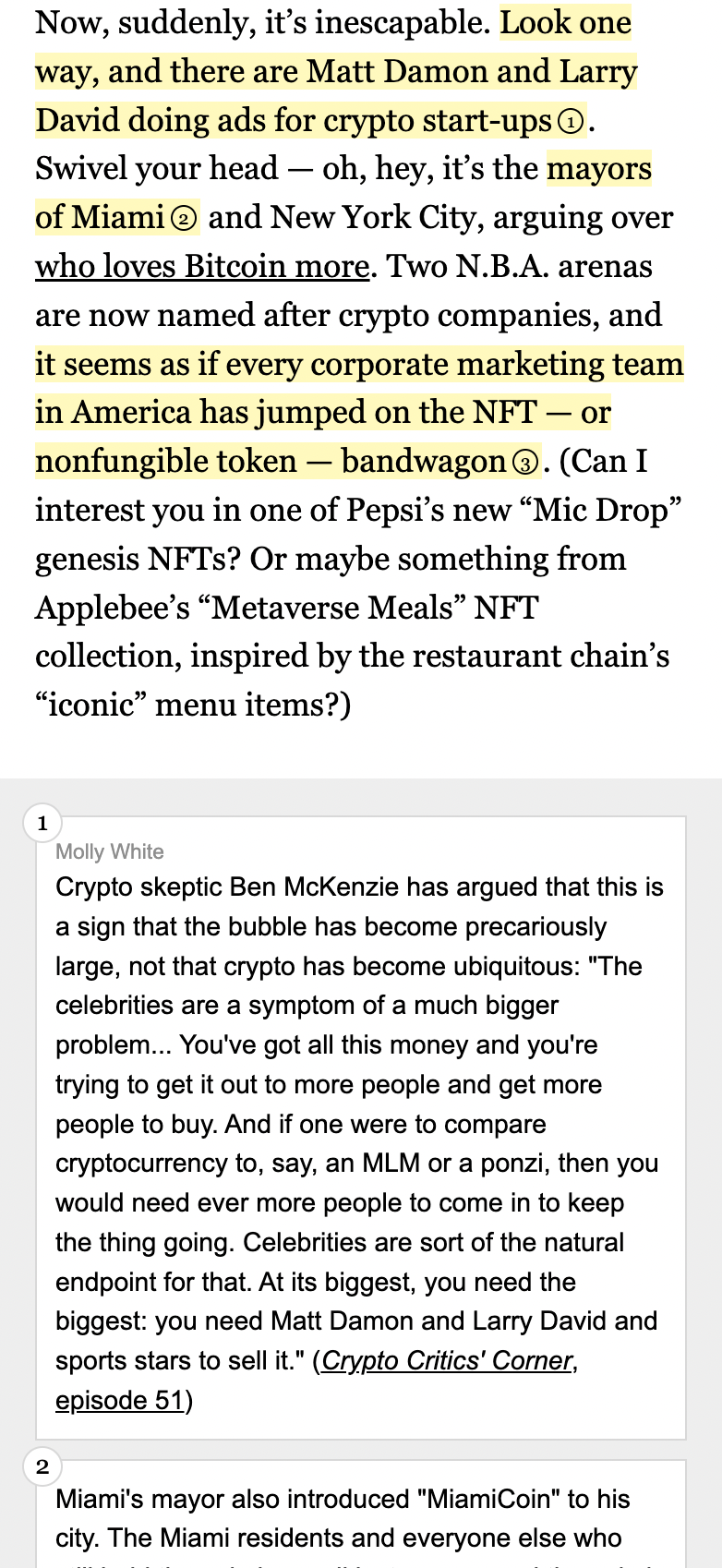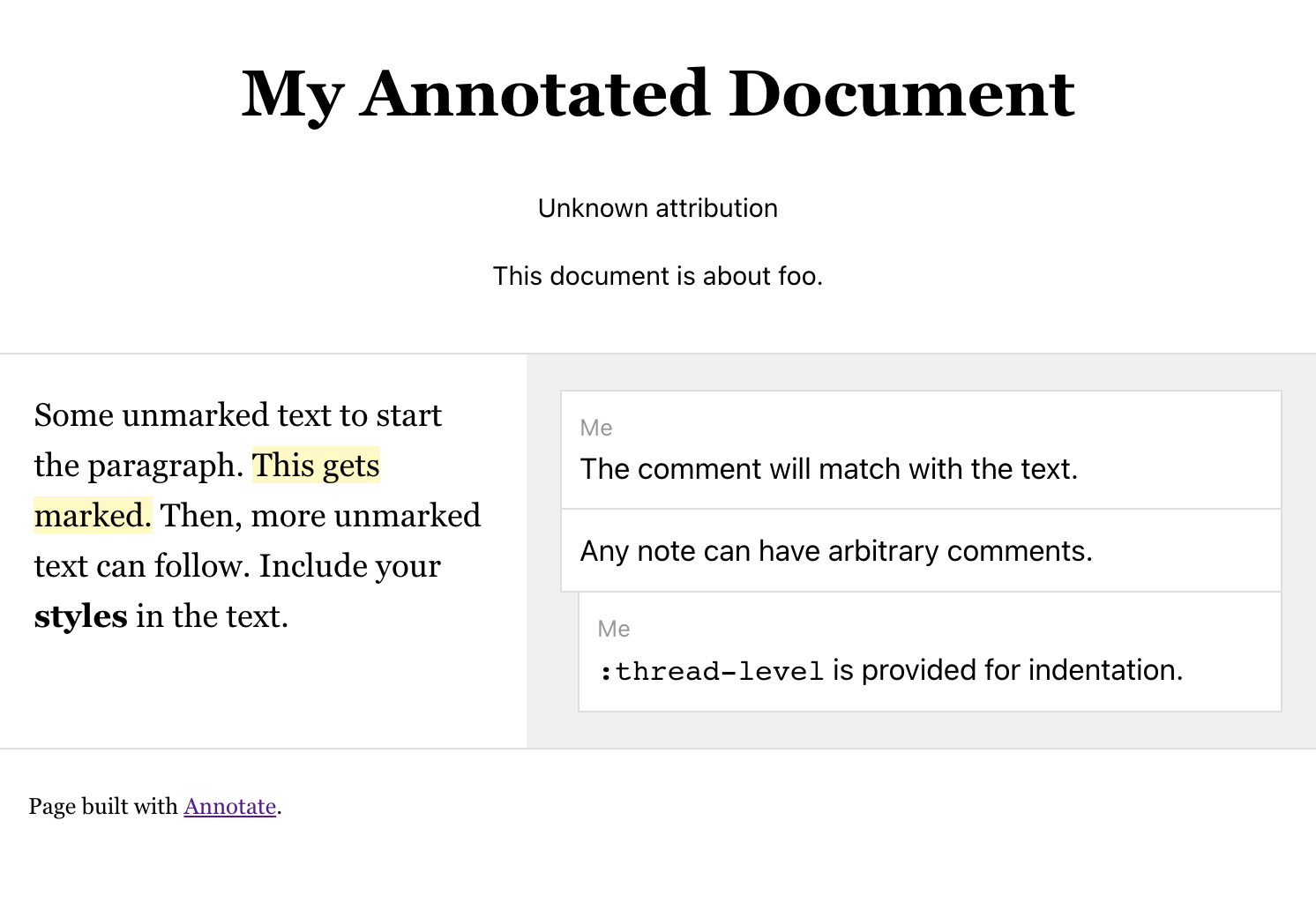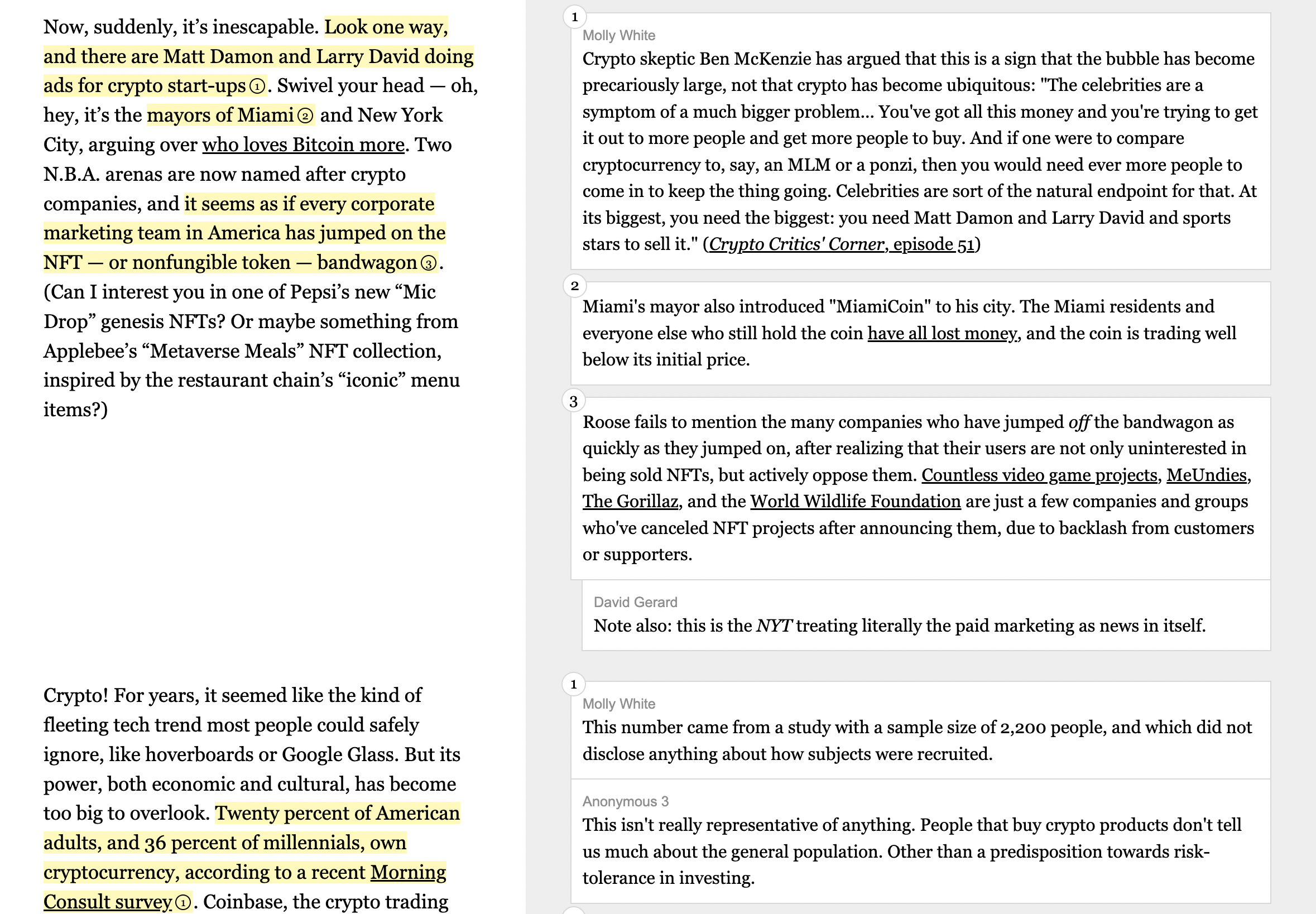annotate has been babashka-fied..
You can generate a near-identical version of the original annotated page style, with highlights and comments, from a given edn file.
Run bb velveteen as a demo to recreate the original example at target/velveteen.html! See what it's generated from in velveteen.edn.
Currently, writing out a datafile is pretty painstaking, about as much as DIY html.
What could come next? Scrape text sources from the web and conform them to annotation format? Create annotations with a web gui by selecting text and adding comments? Collaboratively publish annotated documents without handwriting code?
There are already a couple hacks in place for certain features. However, the templating is as straightforward as it is extensible. See each modular piece in templates.
spec
What should the edn file look like?
{:title "My Annotated Document"
:authorship "Unknown attribution"
:frontmatter {:bylines ["This document is about foo."]}
:content [[{:text "Some unmarked text to start the paragraph."}
{:text "This gets marked."
:mark {:id "descriptive-or-nondescript-id"
:comments [{:text "The comment will match with the text."
:commenter "Me"}
{:text "Any note can have arbitrary comments."}
{:text "<code>:thread-level</code> is provided for indentation."
:commenter "Me"
:thread-level 1}]}}
{:text "Then, more unmarked text can follow."}
{:text "Include your <strong>styles</strong> in the text."}]]}Will become...
Give a different vector of maps to :content for each paragraph, each containing :text and optionally :mark.
Then, any of the following keys can be optionally provided for document-level metadata:
{:frontmatter {:bylines []
:intros []}
:backmatter {:outros []
:fine-prints []}
:meta {:description ""
:locale "en_US"
:theme-color ""
:site-name ""
:image ""
:image-alt ""
:image-width ""
:image-height ""
:url ""
:twitter-card ""
:twitter-creator ""
:icon {:apple-touch-icon ""
:icon-png-32x32 ""
:icon-png-16x16 ""}}}
;; Should probably be namespaced and not nested.Each section in the frontmatter and backmatter are vectors of HTML strings.
Tools used are:
@molly's information
Annotate
Annotate and publish text on the web! This project was created for "The (Edited) Latecomer's Guide to Crypto", but can be used to annotate any text document.
View a live demo at https://molly.github.io/annotate/.
How to use
Copy the index.html, styles.css, and annotate.js files to your project. You should only need to edit the index.html file, unless you want to change the styling or JavaScript behavior. This project does not require the JavaScript, so if you want to leave it out, just omit the annotate.js file and remove the <script src="./annotate.js"></script> tag from the HTML file. The repo-assets folder has full-size repo-assets of the index page in both desktop (index-desktop.png) and mobile (index-mobile.png) views, so you can see what the HTML produces.
Each section of the document follows this basic structure:
<section class="group">
<div class="content quote">
Text that's being <mark data-annotation-id="1" aria-details="unique-comment-id">annotated</mark>.
</div>
<div class="content note">
<div class="annotation" role="comment" data-annotation-id="1" id="unique-comment-id">
<div class="commenter">Commenter name</div>
Comment text.
</div>
</div>
</section>and produces:
Details
Each section of text is captured in a row with left- and right-hand sections. The <section class="group"> element represents this row. Each side then has a div with the content class and either the quote or note classes. quote is the text being annotated, note is for the annotations.
Each portion of highlighted text in the original source (left-hand side) is marked with <mark> tags. These must have a unique aria-details attribute that will correspond to the id of the annotation, which will enable visual focus highlighting on click. It can also optionally have a data-annotation-id to number the annotation, to help distinguish annotations when there are multiple in a section.
Corresponding to the <mark> tag will be a div with either the annotation or annotation-group class on the right-hand side (the former for single annotations, the latter for grouped annotations). These must have role="comment" and an id that exactly matches the unique aria-details value of the highlighted text to which it corresponds. As with the highlighted text, it can have a data-annotation-id to number the annotation.
Grouped annotations
Within an annotation group, there will be one or more divs with the annotation class. These can contain a div with the class commenter to identify the writer, if there are multiple annotators working on the document. These do not need role="comment, data-annotation-id, or id since they're nested within an annotation-group with those attributes.
In the case of multiple annotations within an annotation group, they can appear directly stacked, or threaded (rendering with increasing levels of indentation, to indicate that they are replies to one another). To thread comments, include the thread class on the second comment (the first reply). Any subsequent replies should be marked with the thread-x class, where x is the level of indentation from 2–10: thread-2, thread-3, ..., thread-10. Omit the thread classes to render multiple annotations in a stack without indentation.
<section class="group">
<div class="content quote">
Text that's being <mark data-annotation-id="1" aria-details="unique-comment-id">annotated</mark>.
</div>
<div class="content note">
<div class="annotation-group" role="comment" data-annotation-id="1" id="unique-comment-id">
<div class="annotation">
A comment with indented responses.
</div>
<div class="annotation thread">
A reply
</div>
<div class="annotation thread-2">
A second reply
</div>
</div>
</div>
</section>Other source formats
The original Latecomer's Guide project was created using Pug and Sass. If you'd rather work with those, that source code lives over with my website source:
Mobile display
This is how the annotations display on mobile:





